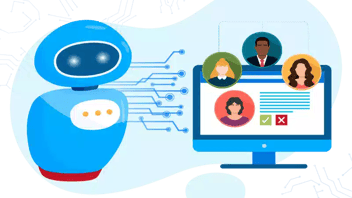From Recruitment to Retention: AI Tools for HR Decision-Making
Workforces evolve. The way companies manage them must evolve, too. As companies expand, sustainability depends on efficiency. The old HR model of manual screening, stacks of paperwork, and subjective reviews is fading, and automation is taking hold.
Companies now scan thousands of applications in moments, detecting nuances that once took weeks to uncover. This simplifies hiring and assures a more accurate selection process. AI tracks engagement, identifies potential departures before they happen, and personalizes training to match individual learning styles.
However, with this change comes a challenge: How do companies ensure that technology improves judgment but doesn't replace it? The balance between automation and human insight remains a core debate.
This article explores how AI tools streamline HR operations. It examines recruitment, onboarding, performance, engagement, and retention. From selecting employees to ensuring engagement, AI makes HR efficient.
1. AI in Recruitment
The right people in the right roles — and a company's ability to find them is core to the success of any organization. A bad hire costs companies time, money, and productivity. Recruiters use data-driven techniques to reduce hiring errors. According to the report, a poor hiring decision can cost 30% of the employee's annual salary. Artificial intelligence tools create employment processes effectively to minimize such risks.
Automated Job Postings and Candidate Sourcing
AI-powered recruitment platforms analyze job descriptions and suggest better wording. Well-crafted job postings attract top-tier professionals. This ensures postings attract the most relevant candidates. At the same time, these systems comb through vast networks, browsing through professional profiles, job boards, and internal databases. Advanced algorithms match candidates to jobs more accurately. They make connections, spot hidden talent, and surface potential hires who might have otherwise remained invisible.
Key Benefits:
-
Reaches a wider pool of qualified candidates.
-
Matches job requirements with applicant skills more accurately.
-
Saves recruiters hours of manual work.
-
Improves employer branding by improving job descriptions.
-
Enhance candidate experience through speedy, automated communication.
-
Integrates with HR software to streamline hiring processes.
Resume Screening and Shortlisting
A conventional resume screening process is slow-moving and susceptible to human error. It may overlook highly qualified candidates. With AI-powered Applicant Tracking Systems (ATS), resumes can be parsed in seconds, and candidates can be ranked based on their qualifications and experience. These tools evaluate skills, work history, and even subtle indicators of success like career momentum or whether a candidate has grown steadily or jumped unpredictably.
AI Chatbots for Initial Screening
Recruiters often spend hours answering basic candidate questions. This delays decision-making and slows hiring progress. AI chatbots handle this efficiently as they:
-
Conduct preliminary interviews via chat or voice.
-
Ask role-specific questions to gauge suitability.
-
Provide real-time updates on application status.
-
Improve accessibility for global candidates with bilingual skills.
-
Gather structured interview data to improve hiring analytics.
-
Reduce time-to-hire by quickly screening top applications.
Recruiters are able to focus on more strategic responsibilities while simultaneously improving the prospect experience. If you are concerned that employing a chatbot will take away your recruitment campaign’s authenticity, review these DEI tips for AI integration without losing the human touch
Reducing Hiring Bias
Unconscious bias infiltrates hiring decisions and hinders diversity. AI addresses this by evaluating candidates solely based on skills and experience. Objective evaluations create a more inclusive workforce.
According to a study, companies with diverse teams perform better financially by 15%. Diversity leads to increased innovation and problem-solving. AI-based hiring allows more fairness in the recruitment process, followed by diversity in the workplace.
2. AI in Employee Onboarding
The first days in a new role are a mix of excitement and information overload. Excessive documentation frequently overwhelms new hires. Indeed, companies expect employees to absorb policies, complete training, and sign documents in a rigid manner. Artificial intelligence changes that by making onboarding dynamic and tailored to the individual. Personalized experiences make transitions smoother for employees.
Automating the Onboarding Process
-
AI verifies documents and ensures compliance with company policies.
-
Automated workflows eliminate paperwork, reducing administrative burdens.
-
New hires receive step-by-step guidance on what to complete next.
-
Reduces human mistakes in documentation.
-
Encourages access to essential tools and resources.
-
Enhances engagement through dynamic onboarding experiences.
Personalized Onboarding Experiences
Not all employees have the same learning needs. AI customizes onboarding experiences by:
-
Assigning personalized training modules based on job roles.
-
Scheduling onboarding sessions tailored to individual progress.
-
Recommending mentors based on shared interests and skills.
-
Multimedia information supports a variety of learning techniques.
-
Increases early productivity by prioritizing essential duties.
-
Automatically collects input to improve onboarding quality.
AI-powered Virtual Assistants
AI chatbots provide instant support to new employees. They answer common questions, help with IT setup, and guide employees through HR processes. This ensures smooth onboarding with minimal human intervention. Employees feel supported from day one. It also:
-
Improves retention by making employees feel appreciated from their first day.
-
Provides possibilities for continuing learning beyond onboarding.
-
Reduces the administrative workload for HR staff.
3. AI in Performance Management
Sustained business growth relies on effective performance assessment. AI tools provide managers with real-time insights into employee performance, enabling them to deliver timely feedback and targeted support. Data and AI consultants play a key role in helping organizations, including federal agencies, implement intelligent systems that streamline operations, improve employee engagement, and support evidence-based decision-making.
Real-time Performance Tracking
Instead of waiting for annual performance reviews, companies now use AI-driven systems to track employee progress daily. Frequent feedback enhances employee motivation. These tools:
-
Analyze work patterns and identify areas for improvement.
-
Provide automated feedback based on completed tasks.
-
Detect performance trends that could indicate burnout or disengagement.
-
Encourages a growth mindset with timely feedback loops.
-
The use of objective data reduces manager bias.
-
Sets realistic performance benchmarks.
Data-driven Employee Assessments
Performance evaluations have traditionally been subjective. AI improves this process by:
-
Using data analytics to assess employee contributions.
-
Comparing performance against industry benchmarks.
-
Providing objective insights that help managers make fair decisions.
-
Selecting high-potential employees for leadership development.
-
Eliminating partiality by concentrating on data-driven measures.
-
Optimizing performance improvement initiatives for problematic employees.
AI in Goal Setting and Career Development
Employees want to know how they can grow within a company. AI-powered systems help by:
-
Identifying career paths based on an employee's skills and achievements.
-
Suggesting training programs that align with career goals.
-
Providing personalized coaching recommendations.
-
Aligning employee goals with company needs.
-
Enhancing succession planning for key roles.
-
Improving job satisfaction by outlining clear career paths.
Companies using AI for career development see higher retention rates as employees feel more valued and supported in their growth.
4. AI in Employee Engagement and Well-being
When employees feel valued and heard, their performance improves. Engaged employees contribute more effectively. However, efforts to gauge sentiment across an entire organization tend to miss the full picture. AI helps companies uncover hidden stressors, identify cultural strengths to understand employee sentiment and improve workplace culture. Data-driven insights empower HR teams.
It also offers data-driven insights that help leaders create environments that support the employees' well-being.
Sentiment Analysis and AI-powered Surveys
AI analyzes employee feedback from surveys and emails to measure overall sentiment. This helps HR teams:
-
Identify workplace concerns before they escalate.
-
Understand trends in employee satisfaction.
-
Take action to improve engagement levels.
AI Chatbots for Mental Health & Well-being
AI-powered mental health tools provide employees with resources to manage stress. These include:
-
Guided meditation sessions.
-
24/7 chatbot support for workplace concerns.
-
Personalized wellness recommendations.
AI in Workplace Culture Development
AI helps businesses create a positive work environment by:
-
Identifying areas where team collaboration can improve.
-
Recommending strategies to enhance workplace diversity.
-
Encouraging employee recognition through automated reward systems.
Companies using AI for workplace culture improvements report a 10% increase in employee satisfaction.
5. AI in Employee Retention
Retaining top talent is just as important as hiring the right people. Losing skilled employees disrupts business continuity. AI tools help businesses keep employees engaged and reduce turnover rates. AI-driven insights enable proactive retention strategies.
Predictive Analytics for Turnover Prevention
AI can detect early signs of employee dissatisfaction. Early intervention helps prevent unnecessary resignations. It does this by:
-
Analyzing work patterns and engagement levels.
-
Monitoring absenteeism and productivity drops.
-
Predicting which employees are likely to leave.
When companies act on these insights, they reduce turnover and improve retention rates. Proactive retention measures strengthen workforce stability.
AI-driven Learning & Development Programs
Employees stay longer when they have opportunities to grow. Lack of growth leads to disengagement and job-hopping. AI enhances learning programs by:
-
Personalizing training based on individual career goals.
-
Recommending courses based on industry trends.
-
Tracking learning progress and suggesting next steps.
AI-driven learning programs also help cloud migration consultants by recommending industry-specific certifications and training to stay competitive. Targeted training improves employee expertise and career progression.
AI in Compensation & Benefits Optimization
Competitive salaries and benefits keep employees motivated. Fair pay structures boost job satisfaction. AI helps companies:
-
Analyze market data to offer fair compensation.
-
Customize benefits packages based on employee preferences.
-
Adjust salary structures to match performance and market trends.
-
Identify patterns in team morale over time.
-
Real-time sentiment analysis can help executives make more informed decisions.
-
Provide anonymous feedback mechanisms to encourage honest responses.
Thus, businesses can decrease turnover and increase worker satisfaction by optimizing compensation plans with AI. Financial incentives, when well-structured, improve retention rates.
Conclusion
The appeal of AI is undeniable: fewer missteps and fewer oversights.
Efficiency increases as manual tasks decrease. It streamlines hiring, refines processes, and identifies patterns that signal retention or attrition. In theory, its role in human resources leads to fairer outcomes, more accurate data, and fewer inefficiencies. Proponents argue that employees benefit from systems designed to anticipate their needs, and research lends support to this view.
AI transforms HR into a proactive function. However, for all its efficiencies, AI does not (and should not) supplant human judgment. Emotional intelligence remains irreplaceable in HR. A company runs on structure, but it is held together by recognition and the moments that remind employees they are more than numbers.
The most effective HR teams recognize this. They employ AI as a tool to enhance decisions, not to make them.
This content is also available in:
- German: KI-Tools in der HR: Effiziente Rekrutierung und Mitarbeiterbindung
- Spanish: IA en RRHH: del reclutamiento a la retención de talento
- French: L'IA en RH: de l'embauche à la fidélisation des talents
- Italian: IA nelle Risorse Umane: Dal Reclutamento alla Fidelizzazione
- Romanian: Instrumente AI pentru HR: de la recrutare la retenția angajaților
- Chinese: 从招聘到留任:用于人力资源决策的人工智能工具

Opinions expressed in this article are those of the guest author. Aspiration Marketing neither confirms nor disputes any of the conclusions presented.









Leave a Comment